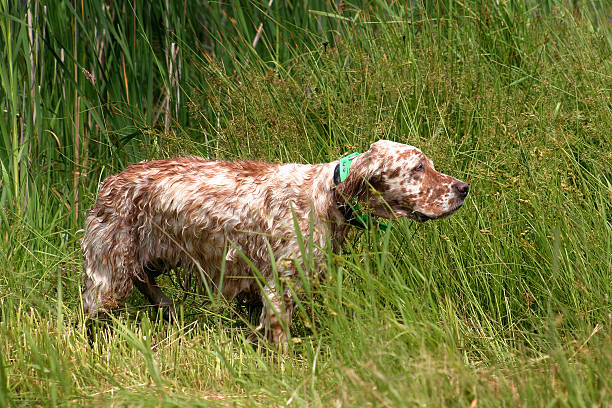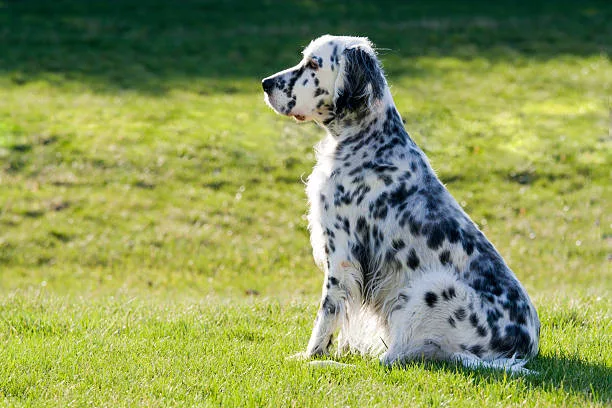English Setters are widely recognized for their elegant appearance, gentle temperament, and keen hunting instincts. These loyal companions have graced homes for centuries, captivating hearts with their intelligence, eagerness to please, and affectionate nature. If you’re considering welcoming an English Setter into your life, this comprehensive guide will equip you with the knowledge and insights to ensure a fulfilling and harmonious partnership.
A Brief History of the English Setter

The English Setter traces its lineage back to the 16th century, originating from crosses between various Spaniel breeds in England and France. Their exceptional bird-hunting abilities quickly gained recognition, making them prized possessions among sportsmen. Over time, the breed underwent selective breeding, refining their appearance and enhancing their hunting prowess.
Origin and Development
The exact origins of the English Setter are unknown, but it is believed that they were developed from crosses between the Spanish Pointer, Springer Spaniel, and Water Spaniel. They were initially used as a bird dog, flushing out game birds for hunters. As their popularity grew, they were also used for retrieving and pointing, making them versatile hunting companions.
In the 1800s, the English Setter was further refined by Edward Laverack and R. Purcell Llewellin, who focused on developing a more elegant and refined appearance while maintaining their exceptional hunting abilities. This resulted in two distinct types of English Setters – the Laverack Setter and the Llewellin Setter.
The Laverack Setter is known for its longer, flowing coat and more substantial build, while the Llewellin Setter has a shorter coat and a leaner body. Both types are still recognized today, with the Laverack Setter being more commonly seen in show rings and the Llewellin Setter excelling in field trials.
Recognition as a Breed
The English Setter was officially recognized as a breed in 1878 by the American Kennel Club (AKC) and the United Kennel Club (UKC). Today, they are also recognized by other major kennel clubs, including the Canadian Kennel Club, The Kennel Club (UK), and the Australian National Kennel Council.
English Setters have also gained recognition for their exceptional abilities in various dog sports, such as agility, obedience, and tracking. They have also been used as therapy dogs due to their gentle and affectionate nature.
Choosing an English Setter Puppy
Selecting an English Setter puppy is an exciting yet crucial decision. Responsible breeders prioritize the health and well-being of their puppies, ensuring they receive proper care and socialization from an early age. Reputable breeders will readily provide health clearances, documentation of vaccinations, and transparent information about the puppy’s lineage and temperament.

Finding a Reputable Breeder
The first step in finding a healthy and well-bred English Setter puppy is to research and find a reputable breeder. A reputable breeder will prioritize the health and well-being of their puppies and will be knowledgeable about the breed. They will also be willing to answer any questions you may have and provide you with all the necessary information about the puppy’s parents and health clearances.
You can find reputable breeders through referrals from local English Setter clubs or by contacting national breed organizations. You can also attend dog shows and meet breeders in person to get a better understanding of their breeding practices and the quality of their dogs.
Health Clearances
Responsible breeders will ensure that their breeding dogs undergo health screenings for any potential genetic health issues. These screenings may include hip and elbow evaluations, eye exams, and genetic testing for conditions such as progressive retinal atrophy (PRA) and deafness.
Make sure to ask the breeder for documentation of these health clearances before committing to a puppy. This will give you peace of mind and ensure that your puppy has the best chance of living a healthy life.
Welcoming Your English Setter Puppy Home
Preparing your home for your new English Setter puppy is essential for a smooth transition. Here are some tips to help you welcome your new furry friend into your home:

Puppy-Proofing Your Home
Just like human babies, puppies are curious and love to explore their surroundings. Before bringing your English Setter puppy home, make sure to puppy-proof your house by removing any potential hazards such as electrical cords, toxic plants, and small objects that can be easily swallowed.
It’s also a good idea to designate a safe and comfortable area for your puppy to rest and sleep, such as a crate or a designated room. This will not only keep your puppy safe but also help with potty training and establishing a routine.
Introducing Your Puppy to Other Pets
If you have other pets at home, it’s essential to introduce them to your new English Setter puppy slowly and carefully. Start by allowing them to sniff each other through a barrier, such as a baby gate, before gradually allowing them to interact under supervision.
Make sure to give your existing pets plenty of attention and reassurance during this time to prevent any feelings of jealousy or resentment towards the new addition.
Establishing a Routine
English Setters thrive on routine, so it’s essential to establish a consistent schedule for feeding, exercise, and potty breaks. This will not only help with training but also provide your puppy with a sense of security and stability.
It’s also crucial to start training your puppy from day one. English Setters are intelligent and eager to please, making them relatively easy to train. Positive reinforcement techniques, such as treats and praise, work best with this breed.
Caring for Your English Setter
English Setters have a beautiful, silky coat that requires regular grooming to keep it in top condition. They also have high energy levels and require daily exercise and mental stimulation to prevent boredom and destructive behaviors.

Grooming
English Setters have a medium-length coat that requires brushing at least once a week to prevent matting and tangles. During shedding season, which usually occurs twice a year, they will require more frequent brushing to remove loose hair.
It’s also essential to trim their nails regularly and clean their ears to prevent infections. If you’re not comfortable with grooming your English Setter yourself, consider taking them to a professional groomer for regular maintenance.
Exercise and Training
English Setters are an active breed and require daily exercise to stay healthy and happy. This can include long walks, runs, or playtime in a fenced yard. They also excel in various dog sports, such as agility and tracking, which provide both physical and mental stimulation.
Training is also crucial for English Setters, as they can become bored and destructive if left alone for extended periods. Obedience training and fun activities such as trick training can help keep their minds engaged and prevent unwanted behaviors.
Health Concerns for English Setters
While English Setters are generally a healthy breed, like all dogs, they are prone to certain health issues. It’s essential to be aware of these conditions and monitor your dog’s health closely to catch any potential problems early on.
Hip Dysplasia
Hip dysplasia is a common condition in large breeds, including English Setters. It occurs when the hip joint doesn’t develop correctly, leading to pain and mobility issues. Responsible breeders will screen their breeding dogs for this condition, but it’s still essential to monitor your dog’s weight and activity level to prevent any unnecessary strain on their joints.
Ear Infections
Due to their long, floppy ears, English Setters are prone to ear infections. It’s essential to clean their ears regularly and check for any signs of infection, such as redness, swelling, or a foul odor. If you notice any of these symptoms, consult your veterinarian for proper treatment.
Hypothyroidism
Hypothyroidism is a condition that occurs when the thyroid gland doesn’t produce enough hormones, leading to weight gain, lethargy, and skin issues. English Setters are more prone to this condition than other breeds, so it’s essential to monitor their weight and energy levels and consult your veterinarian if you notice any changes.
Video
Conclusion
English Setters make wonderful companions for those looking for an intelligent, affectionate, and active dog. With proper care, training, and socialization, they can thrive in various environments, from city apartments to rural homes.
If you’re considering adding an English Setter to your family, make sure to do your research and find a reputable breeder who prioritizes the health and well-being of their dogs. With the right preparation and care, you can look forward to a fulfilling and harmonious partnership with your English Setter for many years to come.